Updated: AOpen MiniPC – Imitation is the Sincerest Form of Flattery
by Jarred Walton on March 3, 2006 12:05 AM EST- Posted in
- Systems
System Benchmarks
We'll start with the most likely usage scenario, general office and system performance. PCMark 04 and 05 were run along with Winstones 2004. Note that both PCMark versions run some 2D and 3D tests, so the IGP will factor into those scores. The AOpen MZ855 could only complete PCMark04 due to the Intel Extreme 2 integrated graphics.
This is basically what we've come to expect from Pentium M systems. It comes out the slowest of all the tested systems, but even dual core Pentium D systems aren't much faster in business tasks. The fact is that the MiniPC does fine in office tasks - it's up to 35% slower than the A64 4000+, but you'll seldom notice. However, the MiniPC struggles a bit in multimedia tasks and is almost half as fast as the 4000+; in many multimedia tasks you will notice the difference. It's doubtful that anyone would really buy this box with the intention of doing lots of video editing, but it can still best most three-year-old PCs in just about every office-related task. The 2.5" 5400 RPM hard drive also has an impact on overall performance, but it's really not too bad compared to the old 4200 RPM drives from a couple years ago.
The Futuremark products show a bit larger spread, and 3DMark scores are almost superfluous for the test systems. Real games might be able to run on some of the IGP solutions out there, but the demanding titles will often struggle to get playable frame rates even at 640x480 with minimal detail settings. Half-Life (the original) did run quite well on all of the systems at 800x600 and even 1024x768 in some cases, but that's about as far as you'd want to go.
Notice also how much of an impact the 6600 GPU has on the Sempron system: we would rate the 3100+ as being slightly slower than the PM 740 overall, and definitely slower than any of the other tested CPUs in overall performance. However, the fastest systems that we tested with the best IGP solutions currently available are still completely dominated by one of the slowest shipping processors around, once you add in a moderate GPU. Does this mean that the MiniPC (or any of the other systems) aren't worth having? Of course not, provided that 3D/gaming isn't a requirement.
We'll start with the most likely usage scenario, general office and system performance. PCMark 04 and 05 were run along with Winstones 2004. Note that both PCMark versions run some 2D and 3D tests, so the IGP will factor into those scores. The AOpen MZ855 could only complete PCMark04 due to the Intel Extreme 2 integrated graphics.
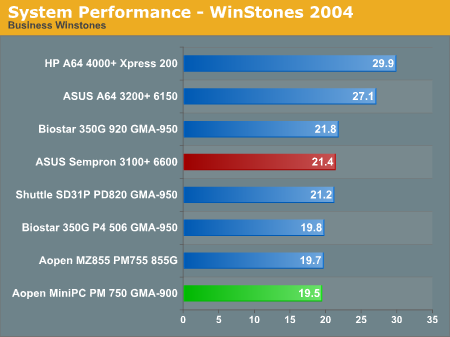
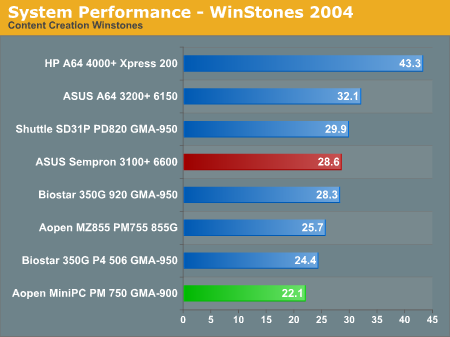
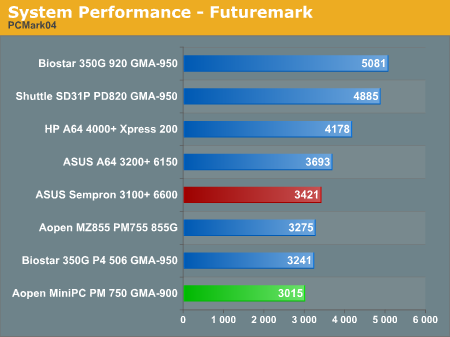
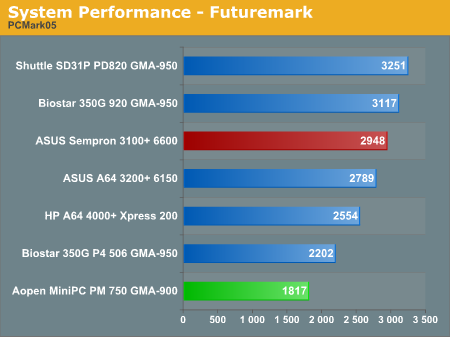
This is basically what we've come to expect from Pentium M systems. It comes out the slowest of all the tested systems, but even dual core Pentium D systems aren't much faster in business tasks. The fact is that the MiniPC does fine in office tasks - it's up to 35% slower than the A64 4000+, but you'll seldom notice. However, the MiniPC struggles a bit in multimedia tasks and is almost half as fast as the 4000+; in many multimedia tasks you will notice the difference. It's doubtful that anyone would really buy this box with the intention of doing lots of video editing, but it can still best most three-year-old PCs in just about every office-related task. The 2.5" 5400 RPM hard drive also has an impact on overall performance, but it's really not too bad compared to the old 4200 RPM drives from a couple years ago.
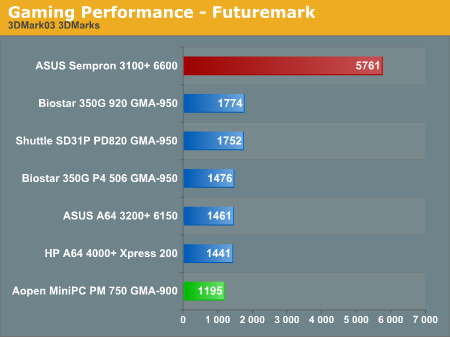
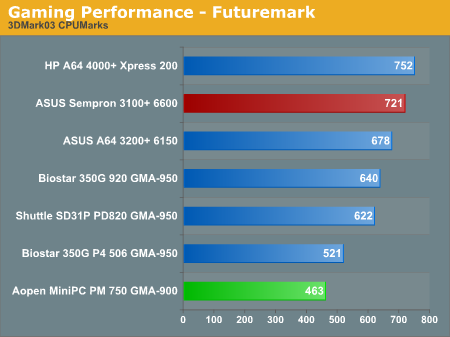
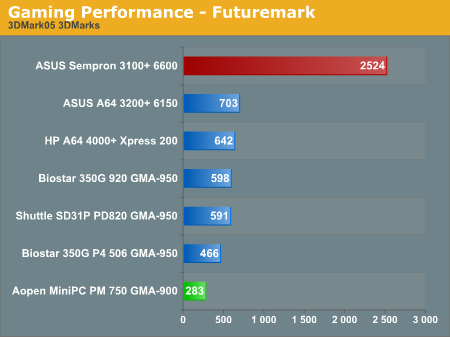
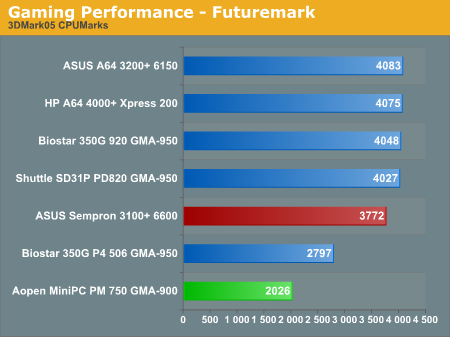
The Futuremark products show a bit larger spread, and 3DMark scores are almost superfluous for the test systems. Real games might be able to run on some of the IGP solutions out there, but the demanding titles will often struggle to get playable frame rates even at 640x480 with minimal detail settings. Half-Life (the original) did run quite well on all of the systems at 800x600 and even 1024x768 in some cases, but that's about as far as you'd want to go.
Notice also how much of an impact the 6600 GPU has on the Sempron system: we would rate the 3100+ as being slightly slower than the PM 740 overall, and definitely slower than any of the other tested CPUs in overall performance. However, the fastest systems that we tested with the best IGP solutions currently available are still completely dominated by one of the slowest shipping processors around, once you add in a moderate GPU. Does this mean that the MiniPC (or any of the other systems) aren't worth having? Of course not, provided that 3D/gaming isn't a requirement.










54 Comments
View All Comments
plinden - Friday, March 3, 2006 - link
Yeah, when are we getting the ability to edit our posts?siliconthoughts - Friday, March 3, 2006 - link
When a genuine mac mini costs less, is more upgradeable (dual core, 2 DDR slots, digital audio, WiFi, Bluetooth, 4 USB ports, faster graphics) comes with a nifty secure OS and includes a whole suite of apps, why would anyone buy this? XP just isn't that great that I'd spend a $300 premium for it on an inferior box.Googer - Friday, March 3, 2006 - link
These are nice, but It is my suspicion that a Turon in an Mini PC would be the faster choice.NegativeEntropy - Saturday, March 4, 2006 - link
Agreed -- a Turion "version" would be interesting. That said, I think this statement from the review could use a bit of modifying:"...if you really want low power, you can go with one of the Pentium M platforms. End of discussion. "Tech Report recently found that the Turion can compete pretty well with the PM on power consumption http://techreport.com/reviews/2006q1/pentiumm-vs-t...">http://techreport.com/reviews/2006q1/pentiumm-vs-t...
JarredWalton - Saturday, March 4, 2006 - link
This isn't meant as a far-reaching statement. What I'm talking about is small form factors, or systems that will compete with the MiniPC. Turion support on socket 754 platforms is lacking, meaning that there are boards that support it but there are definitely boards that won't support it. Most of the socket 754 small form factors are pretty old, so I don't know how many of them would support Turion.The article at Tech Report is interesting, but idle power draw is only half of the question. 94 W at full load really isn't that much better than the rest of the Athlon 64 line. I mean, the HP DX5150 with an old ClawHammer core running at 2.4 GHz is only about 20 W higher. If you were to use a 90 nm Athlon 64, that would cut off 10 W or so right there.
Basically, the Athlon 64 design is really good, and it doesn't require all that much power. However, it still can't really compete with the Pentium M. when you shift to laptops, the whole system probably doesn't consume more than 45 W, so 20 W more for the processor is a major deal. Using desktop systems to try and determine laptop suitability is definitely not the best way to go about it. Ideally, you would want identical laptops, with the only difference being motherboard, chipset, and memory. But that's a story for another day.
Googer - Friday, March 3, 2006 - link
I would love to see this Aopen MINI PC rebench marked with a Pentium M 733 or 753 Ultra Low Voltage Processor that has a Maximum of 5W TDP! I would love to see it compaired against the higher 27W TDP Pentium M 740 in both Power Consumtion and Application benchmarks.I bet that at full load the power usage on full load will drop from 38W (with 740) down to 16w and even lower at IDLE! (10W maybe?) With a processor like that this would be the perfect pc for those guys who like to intergrate computers with their cars. Bye bye VIA C3! (C3 Will have http://www.metku.net/index.html?sect=view&n=1&...">other uses though)
JarredWalton - Friday, March 3, 2006 - link
Actually, with the HDD and other components, the system is probably using around 18W for the system and 7 to 20W for the CPU. It might even be 20-22W for the system. Still, 38W at maximum load (i.e. HDD activity along with 100% CPU) is hardly going to tax a car, I don't think. (But I'm not a car A/V guy, so maybe I'm wrong.)michael2k - Friday, March 3, 2006 - link
You would think, with AOpen's resources, that the AOpen MiniPC would be cheaper than the more powerful and featureful Mac mini.What is AOpen doing that is making it more expensive? It's got an older chipset, slower CPU, less USB ports, no rewritable optical drive, no bluetooth, and no wireless networking.
It's an odd day when buying a Mac is cheaper AND more powerful.
Questar - Friday, March 3, 2006 - link
AOpen isn't isn't a computer manufacturer, they are a board maker. What could they do to bring down the price of a system?jconan - Friday, March 3, 2006 - link
It's the economy of scale! Apple definitely has this contract manufacturing capacity considering its hardware/software business as well as its distribution channels. AOpen is just a manufacturing firm and is not in the software business to install an in house OS and plus it doesn't have sufficient sales offices out in the distribution side to push its wares. They have to rely on major OEMs to buy in bulk quantity to leverage prices with them.